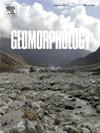Vegetation and the morphodynamics of tidal channels: Insights from Plum Island Sound, Massachusetts
IF 3.1
2区 地球科学
Q2 GEOGRAPHY, PHYSICAL
引用次数: 0
Abstract
The sinuous channels of tidal marshes exhibit marked similarities to their upland counterparts, but their tendency to rapidly narrow into the distal platform may indicate that the processes governing the evolution of form may differ. Additionally, while marsh vegetation facilitates platform aggradation, the role of vegetation in temporally stabilizing the spatially varying channel form remains unclear. Here, we leveraged topographic surveys, historical aerial photos, and sediment cores to evaluate the physical controls on channel migration dynamics within tidal marshes of Plum Island Sound, Massachusetts, USA, a U.S. National Science Foundation Long-Term Ecological Research site. We found that width-normalized rates of channel migration were highest in the distal platform, decreasing exponentially towards the platform edge. This trend coincided with observations of bank instability, in which the frequency of bank slumping progressively increased away from the platform edge. The distal platform, characterized by heightened channel mobility, was also where measured belowground biomass was greatest. The normalized difference vegetation index, reflecting aboveground biomass, was also highest within the distal marsh. We hypothesize that while surface root biomass is denser in the distal marsh, shallow rooting depths may limit the stabilizing influence of vegetation on channel banks, contributing, alongside other factors such as tidal shear stress and seepage-induced erosion, to the enhanced width-normalized rates of channel migration observed in these reaches. Our findings underscore the complex interplay between vegetation and channel morphology in tidal marshes, highlighting the nuanced role of vegetation in platform stability. The work offers insights for the development of adaptive management strategies aimed at preserving these vital coastal ecosystems in the face of sea-level rise.
植被和潮汐通道的形态动力学:来自马萨诸塞州梅岛海峡的见解
潮汐沼泽的蜿蜒河道与高地的河道有明显的相似之处,但它们迅速缩小到远地台的趋势可能表明控制形态演变的过程可能不同。此外,虽然沼泽植被促进了台地的沉积,但植被在时间上稳定空间变化的河道形态方面的作用尚不清楚。在这里,我们利用地形调查、历史航空照片和沉积物岩心来评估美国马萨诸塞州梅岛海峡潮汐沼泽中通道迁移动力学的物理控制,梅岛海峡是美国国家科学基金会长期生态研究基地。我们发现,宽度归一化的通道迁移率在平台远端最高,向平台边缘呈指数下降。这一趋势与对银行不稳定的观察相吻合,在这种情况下,银行滑坡的频率逐渐增加,远离平台边缘。以通道流动性高为特征的远端平台也是测量到的地下生物量最大的地方。反映地上生物量的归一化植被指数在远端沼泽中也最高。我们假设,虽然表层根系生物量在远端沼泽中更密集,但较浅的根系深度可能会限制植被对河道岸的稳定作用,与潮汐剪切应力和渗漏侵蚀等其他因素一起,导致这些河段的河道迁移宽度标准化率增加。我们的发现强调了潮汐沼泽中植被和河道形态之间复杂的相互作用,强调了植被在平台稳定性中的微妙作用。这项工作为在海平面上升的情况下保护这些重要的沿海生态系统的适应性管理策略的发展提供了见解。
本文章由计算机程序翻译,如有差异,请以英文原文为准。
求助全文
约1分钟内获得全文
求助全文
来源期刊

Geomorphology
地学-地球科学综合
CiteScore
8.00
自引率
10.30%
发文量
309
审稿时长
3.4 months
期刊介绍:
Our journal''s scope includes geomorphic themes of: tectonics and regional structure; glacial processes and landforms; fluvial sequences, Quaternary environmental change and dating; fluvial processes and landforms; mass movement, slopes and periglacial processes; hillslopes and soil erosion; weathering, karst and soils; aeolian processes and landforms, coastal dunes and arid environments; coastal and marine processes, estuaries and lakes; modelling, theoretical and quantitative geomorphology; DEM, GIS and remote sensing methods and applications; hazards, applied and planetary geomorphology; and volcanics.
 求助内容:
求助内容: 应助结果提醒方式:
应助结果提醒方式:


